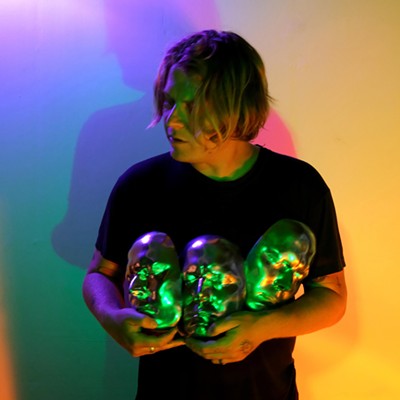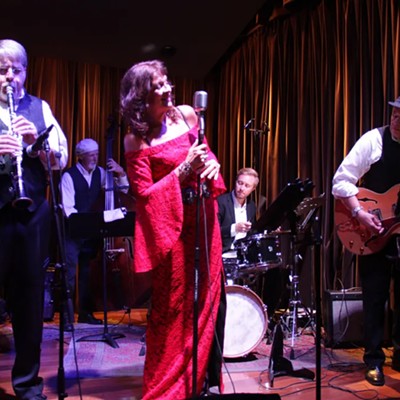When I finally got Norwegian multi-instrumentalist Silje Nes on the phone to talk about her upcoming album, Optiks (Fat Cat), I was immediately apologetic: My computer had crashed, and I had missed my interview time. But Nes seemed unfazed, which in retrospect is all the more indicative of her quiet and calm demeanor.
Once I got my computer back up, I saw an e-mail from her publicist saying that Nes had been having trouble getting her U.S. visa; she wanted to know if we could postpone the interview. So not only did I call late; I called in the middle of a potential crisis. But Nes' voice never once betrayed a hint of frustration or stress. Instead, with the same lilting voice she sings with, Nes spoke about making music for Optiks, her follow-up to her first album, 2008's Ames Room.
On Ames Room, Nes, who currently lives in Berlin, creates cloudlike atmospheres with sounds ranging from watery plinks to guitars, while her voice, in various layers, hesitantly fills in the negative spaces. She sounds incredibly small, but in control, as if she is in the middle of a small room conducting a small, ethereal orchestra. The album is intimate but diverse, moving from more acoustic-leaning sounds to more electronic ones.
"(Ames Room) took many years, just collecting things that I've done for a lot of years," explained Nes, who is a classically trained pianist. She began recording her own music in 2001, when, she explained, she figured out how to do it on her own using a laptop.
"Collecting" is a good word to use to describe what Nes does: Home-recorded music of decades past was often punctuated by static and spontaneous found sounds, with that "bedroom" feel coming from the minimal instrumentation and actual sounds of the instruments echoing off the walls and sheets. But Nes' music is carefully constructed to include a variety of unique sounds with crystalline perfection while still maintaining that intimate feel.
But for Optiks, which will be released this fall, Nes didn't have the same luxury of time and already-finished material to draw from, so the process of creating the album was much different.
"This one was more intense, in a way," she said. "I've been on tour, and I just stopped for maybe a year and a half and just made new things that belong together in a different way than the first one. So it feels more like one piece of work that links together."
Optiks is still in many ways a collection, though: Each song is still a compilation of sounds and instruments that Nes carefully pieces together.
"Sometimes I have a feeling like I want to try this instrument or something like that," said Nes. "It's also basically just what I have around me, and what I have access to. I buy strange instruments from flea markets and things like that. I guess I get curious about different things and how they will work."
More instruments make appearances on Optiks than on Ames Room, like the concertina Nes remembers buying in a tiny shop "in the middle of America somewhere" the last time she toured in the U.S., and a zither she bought at a flea market.
But perhaps the most significant difference between Ames Room and Optiks is Nes' voice, which is markedly more prominent. Her soft vocals may only be pushed up a notch or two in the mix, but the melodies Nes is singing this time make the vocals seem less subdued. On "Crystals," the first single released from Optiks, Nes' voice follows a viola melody, and then becomes more breathy and haunting on the chorus. At moments, it even becomes front and center, as if Nes is whispering directly into your speakers. The effect is calming and empathetic.
Nes sings in English, which, she explains, is just a result of happenstance. "I guess when I started out making music, the things that I listened to when I did that, or the music that I related to, was music in English," she said. "It is kind of strange, when you think about it, that I don't sing in my own language, but it's just been so natural to me."
The closeness and softness of Nes' voice lets you hear every timbre and shake of each word as it takes its place within the song. Being able to pick up on and understand the images Nes sings about is part of the allure of her music. Some of the song titles on Ames Room are interesting combinations of a visual and a feeling, like "Shapes, Electric," or "Searching, White." Nes describes herself as a very visual person; she even uses a video camera to capture some of the sounds she uses in her songs. The title Optiks, said Nes, is meant to be a nod to the way she connects music with visual images.
"It has to do with how I see the music in a way, when I've done it," she said. "I relate to music in a visual way, but I don't want to explain too much, either. For me, it is also a riddle—it's how I want people to read or interpret the title in their own way."
Even if the listener were without the ability to understand the lyrics, Nes' voice, melodies and myriad instruments would still evoke—or, rather, let you see—images of quiet sunlit corners of forests or comfortably cool rooms in a house furnished with items that speak their own history.








